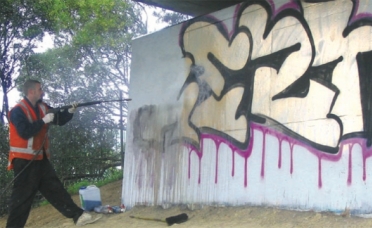Uncategorized
Graffiti
Graffiti
If you are in maintenance, chances are you have had to deal with graffiti in some form or another. It has plagued shopping malls, commercial businesses, factories, highway signs, concrete walls and overpasses. At the national level it is estimated to cost $12 billion annually to clean it up, and while cost may not be that high for individual businesses, it is not usually something you want to leave in place for long. Municipalities tend to take the brunt of the defaced property and therefore higher removal costs. Using the proper cleaning methods and products can help to ensure it is removed as safely and completely as possible.
So the question is why? Why do people do this to property that is not theirs? Though there are no ‘good reasons’ to deface property, the answers range from anger, notoriety, recognition, belonging or marking territory, to artistic expression and displaying one’s skills (though in a very misguided manner). There is a difference between vandalism and artistic expression, which can be called urban art, however art accounts for only about 1% of graffiti markings.
Graffiti should be removed as soon as possible so that is does not cause damage to decorative surfaces or surfaces susceptible to etching. First impressions are important and affected areas may start to look run down and appear threatening, possibly even putting off customers and prospects. Some graffiti can be offensive, threatening, or racially abusive. Eliminating graffiti as soon as it appears also makes it much easier to remove and reduces the chances of vandals doing it again if consistently removed quickly.
Techniques for graffiti removal may include painting, scraping, chemical graffiti removers, power washing, abrasive blasting and graffiti removal gel. You will need to take into consideration the structure of the area affected and the surface material when deciding which techniques and products to use. There are a variety of chemicals that can be used such as safer soy-based products, chemicals to use in conjunction with a pressure washer, and sprays or gels. You should seek expert advice when using chemicals or a pressure washer to remove graffiti as it can damage surfaces further if not used correctly.
Preventing or deterring graffiti vandals in the first place is the best line of defense. Natural deterrents such as landscaping with shrubs or thorny plants can help to restrict vandal access to walls and moving bins or covering anything that can be climbed or scaled will help limit roof access. Flood lights and motion sensor lights can be a cost-effective added level of protection. Preventive coatings or anti-graffiti paints can be used to ensure areas that are tagged, etched or lightly scratched will easily come clean and will help prevent damage to the underlying surfaces. There are sacrificial coatings that help the graffiti come off easily and will need to be reapplied each time graffiti is removed. Semi-sacrificial coatings actually penetrate the substrate to help seal it and protect the pores of a wall. Reapplication is suggested but not required each time graffiti is removed. Permanent coatings form a protective barrier that do not allow the spray paint to bond to the surface. Cleaning is much faster and reapplication is not needed when cleaned correctly.
We can all do our part by reporting graffiti when it is noticed and cleaning the surfaces as soon as possible to help mitigate the problem.

